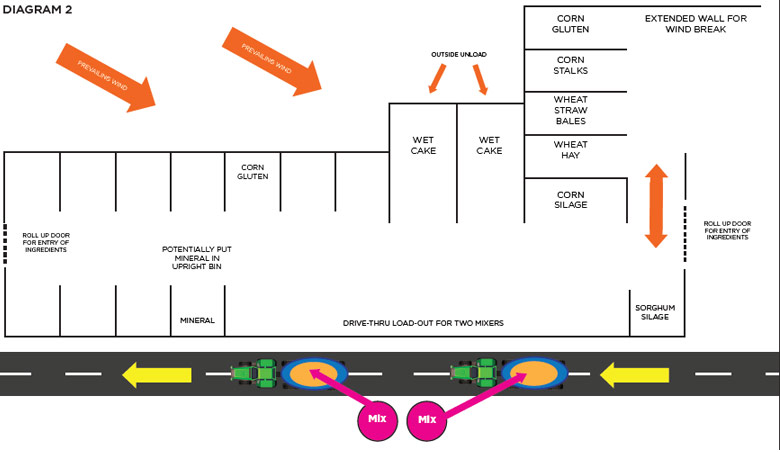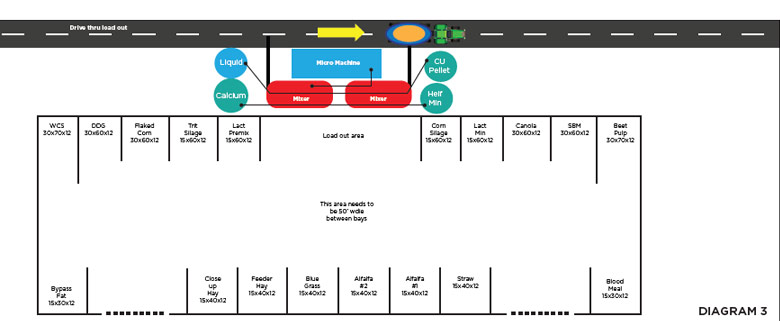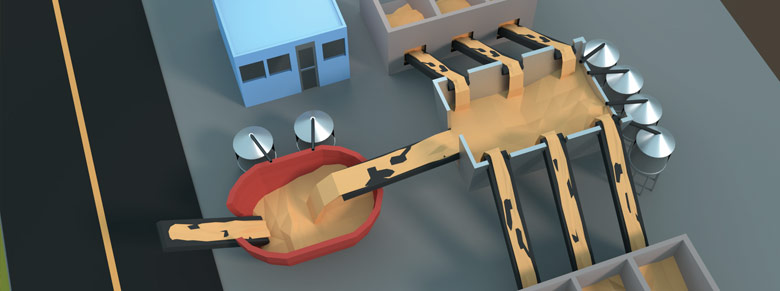Layout and design of your feed center can save you more money, or cost you more money, depending on your operation. There are many different ways to build a feed center that will work for you. You have to decide what type best fits your management style. Maybe a fully automated system is best suited to your management capabilities to allow you to feed with minimal labor. Or, you may want to have a feed center that has little to no mechanization, other than a loader and a mixer. Another way may be to use a combination of the best features of both to maximize your feeding operation’s efficiency. Studies have shown that as tons of feed per labor hour increase, typically the cost per ton to deliver the feed decreases, which means the layout and design is critical to the overall efficiency of your dairy’s feeding operation by having the feedstuffs as close to the loading area as possible. Do your homework on feed center design and layout before you pour concrete and can’t change it. Go visit as many different feed centers as you can, and ask the operator’s thoughts on each type of feed center visited. You can take the best ideas from several and incorporate them into one that best suits your operation. To give you an idea of the possible designs, find generalized layouts for the three types below.
Fully Automated Feeding System
A fully automated feeding system can be very efficient but is likely to have a higher initial investment and may require a skilled, mechanically- minded person to be on staff to repair and maintain the system (Diagram 1). Such a system can substantially reduce labor costs, especially a robotic type system. The robotic systems are set up to deliver smaller loads more frequently throughout the day, which can also help with cow health and feed efficiency.

Minimal Mechanization Feed Center
Feed center systems with minimal mechanization are more buildings and concrete than anything else. The only mechanized parts consist of the loader and mixing and delivery system. This type of system is designed to have fewer moving parts so that breakdowns are less of a concern. When designed properly, these systems can feed a large herd very fast. They can be designed as buildings with commodity bays or as feed bins with drive-under, gravity-flow load-out. A common type of minimal mechanization system consists of mobile type mixers and loaders (Diagram 2).

Combination Feed Center
A combination feed center system is a very common type in any area of the U.S. Such a system may consist of commodity bays for part of the ingredients and bins for other, higher priced, lower inclusion ingredients. It also may have a smaller footprint building with outside pits to receive ingredients. The dump pits may have a live bottom to carry ingredients over the top of the bays and drop into the bays, rather than having ingredients hauled into the building with delivery trucks. Auger delivery is very efficient because ingredient unloading never interferes with making TMR (total mixed ration) loads.
These systems typically have less mechanization, but still may have a considerable amount of technology involved. “Micro machines” are seen in this type of system (Diagram 3), allowing the producer to practice precise feeding on every load if desired, which can be very profitable. Without the micro machine, this feed center is considered a minimal mechanization system.

Remember…
Here are key things to remember when designing your feed center:
• Always keep off-farm traffic separate from on-farm mixing traffic. This is important for multiple reasons, First, ingredient unloading never needs to interfere with making on-farm loads. Second, traffic separation reduces safety issues around the feeding operation. Finally, this practice decreases the likelihood of biosecurity challenges.
• Adequately size the bays for your operation. The best way to calculate the bay size is to take your daily usage of ingredients and decide what inventory you are most comfortable having on hand. Calculate the cubic feet of space you need for that amount and size your bays accordingly. Depending on the spacing of the building, for example, it may be be a 24- foot on-center building. You could have 12-foot-wide bays or 24-foot-wide bays depending on what might be needed.
• Be able to unload various types of delivery trucks so that you can take advantage of opportunity ingredient buys. Certain delivery trucks can have lower freight rates because they can haul more weight. Over a large volume of ingredients, a small per-ton savings can add up to a significant amount on an annual basis.
• Always have one or two “flex bays” designed into your building. You can never have enough storage. There may be opportunities to buy ingredients and to have a need for that extra storage. Flex bays allow you to take advantage of those opportunities.
• Design the facility to be completely under roof and out of the weather. Wind is a major cause of increased shrink.
• If possible, have a platform scale for delivery trucks to weigh in and weigh out. This allows you to precisely track inventory and shrink and not have to rely on invoice weight amount.

